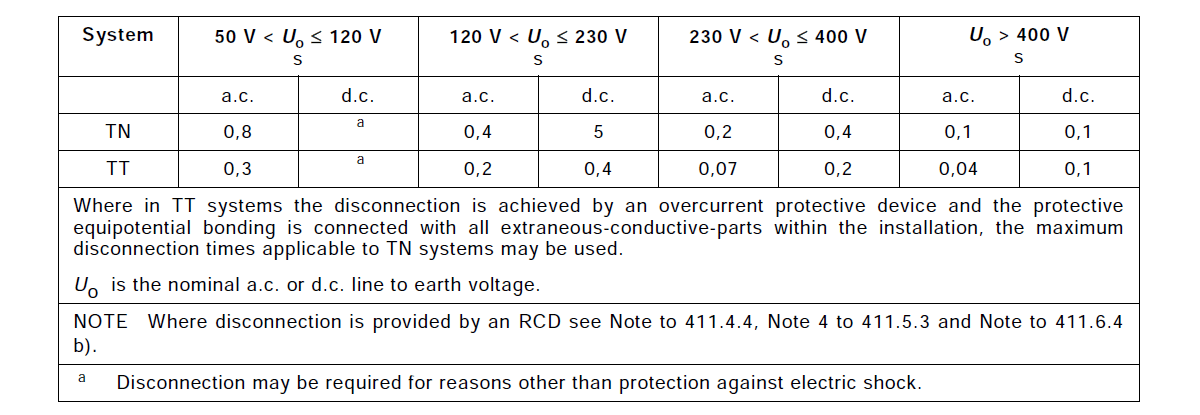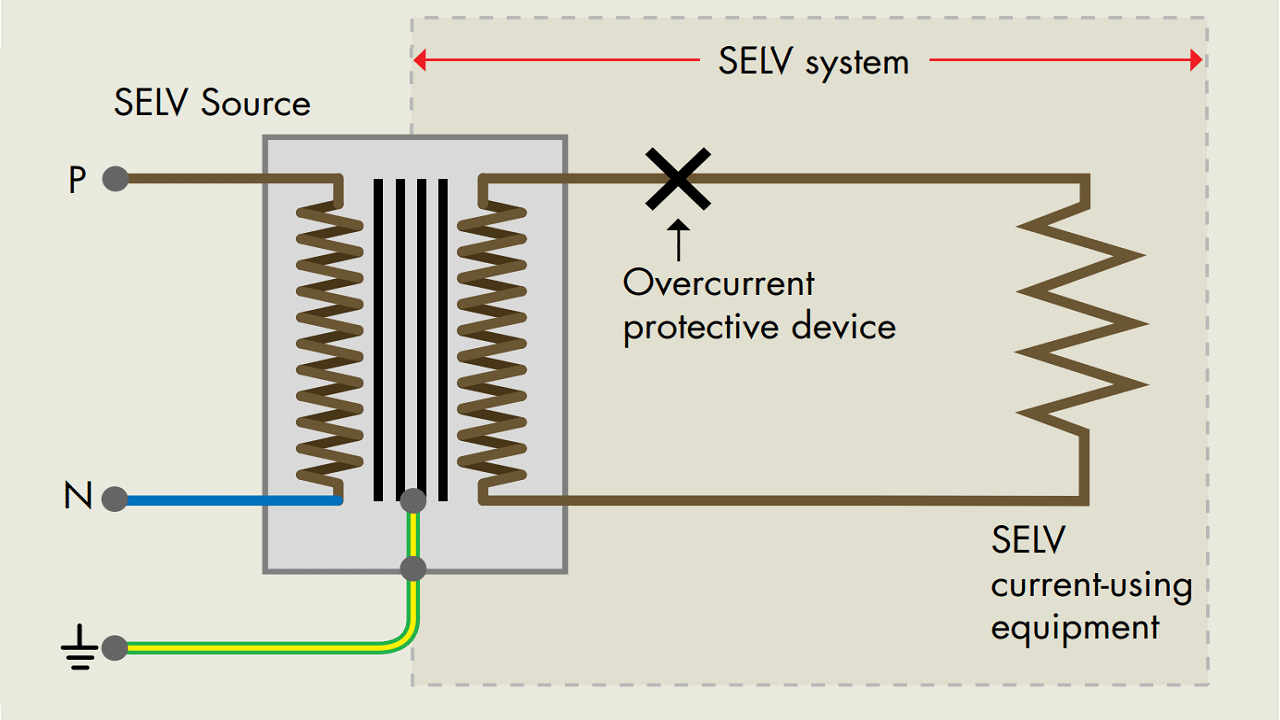Electrical separation is a protective measure in which hazardous-live-parts are insulated from all other electric circuits and parts, from local earth and from touch (Source: IEC 61140-2016).
Electrical separation is a protective measure in which:
- basic protection is provided by basic insulation of live parts or by barriers and enclosures and
- fault protection is provided by simple separation of the separated electric circuit from other circuits and from earth.
This protective measure shall be limited to the supply of one item of current-using equipment supplied from one unearthed source with simple separation.
NOTE. When this protective measure is used, it is particularly important to ensure compliance of the basic insulation with the product standard.
Where more than one item of current-using equipment is supplied from an unearthed source with simple separation, the requirements of subclause “Electrical separation for the supply of more than one item of current-using equipment” shall be met (see below).
Electrical separation of an individual circuit is intended to prevent shock currents through contact with exposed-conductive-parts that may be energized by a fault in the basic insulation of the circuit.
Precautions shall be taken to protect the separated circuit from damage and insulation failure.
The exposed-conductive-parts of the separated circuit shall be connected together by insulated, non-earthed equipotential bonding conductors. Such conductors shall not be connected to the protective conductors or exposed-conductive-parts of other circuits or to any extraneous-conductive-parts.
All socket-outlets shall be provided with protective contacts which shall be connected to the equipotential bonding system.
Except where supplying equipment with double or reinforced insulation, all flexible cables shall embody a protective conductor for use as an equipotential bonding conductor.
It shall be ensured that if two faults affecting two exposed-conductive-parts occur and these are fed by conductors of different polarity, a protective device shall disconnect the supply in a disconnecting time conforming with Table 1.
 Table 1. Maximum disconnection times (source: Table 41.1 of IEC 60364-4-41-2017)
Table 1. Maximum disconnection times (source: Table 41.1 of IEC 60364-4-41-2017)
It is recommended that the product of the nominal voltage of the circuit in volts and length, in metres, of the wiring system should not exceed 100 000, and that the length of the wiring system should not exceed 500 m.
All electrical equipment shall comply with one of the provisions for basic protection. Provisions for basic protection provide protection under normal conditions and are applied where specified as a part of the chosen protective measure.
NOTE. The insulation is intended to prevent contact with live parts.
Live parts shall be completely covered with insulation which can only be removed by destruction.
For equipment, the insulation shall comply with the relevant standard for the electrical equipment.
NOTE. Barriers or enclosures are intended to prevent contact with live parts.
Live parts shall be inside enclosures or behind barriers providing at least the degree of protection IPXXB or IP2X except that, where larger openings occur during the replacement of parts, such as certain lampholders or fuses, or where larger openings are necessary to allow the proper functioning of equipment according to the relevant requirements for the equipment:
- suitable precautions shall be taken to prevent persons or livestock from unintentionally touching live parts, and
- it shall be ensured, as far as practicable, that persons will be aware that live parts can be touched through the opening and should not be touched intentionally, and
- the opening shall be as small as is consistent with the requirement for proper functioning and for replacement of a part.
Horizontal top surfaces of barriers or enclosures which are readily accessible shall provide a degree of protection of at least IPXXD or IP4X.
Barriers and enclosures shall be firmly secured in place and have sufficient stability and durability to maintain the required degrees of protection and appropriate separation from live parts in the known conditions of normal service, taking account of relevant external influences.
Where it is necessary to remove barriers or open enclosures or to remove parts of enclosures, this shall be possible only:
- by the use of a key or tool, or
- after disconnection of the supply to live parts against which the barriers or enclosures afford protection, restoration of the supply being possible only after replacement or reclosure of the barriers or enclosures, or
- where an intermediate barrier providing a degree of protection of at least IPXXB or IP2X prevents contact with live parts, by the use of a key or tool to remove the intermediate barrier.
If, behind a barrier or in an enclosure, items of equipment are installed which may retain dangerous electrical charges after they have been switched off (capacitors, etc.), a warning label is required. Small capacitors such as those used for arc extinction, for delaying the response of relays, etc shall not be considered dangerous.
NOTE. Unintentional contact is not considered dangerous if the voltage resulting from static charges fall below 120 V d.c. in less than 5 s after disconnection from the power supply.
All electrical equipment shall be subject to one of the basic protective provisions in subclause “Provisions for Basic Protection” (see above) or to the protective measure in https://www.asutpp.com/double-insulation.html
The separated circuit shall be supplied through a source with at least simple separation, and the voltage of the separated circuit shall not exceed 500 V.
Live parts of the separated circuit shall not be connected at any point to another circuit or to earth or to a protective conductor.
To ensure electrical separation, arrangements shall be such that basic insulation is achieved between circuits.
Flexible cables and cords shall be visible throughout any part of their length liable to mechanical damage.
For separated circuits the use of separate wiring systems is recommended. If separated circuits and other circuits are in the same wiring system, multi-conductor cables without metallic covering, insulated conductors in insulating conduit, insulated ducting or insulated trunking shall be used, provided that:
- the rated voltage is not less than the highest nominal voltage, and
- each circuit is protected against overcurrent.
The exposed-conductive-parts of the separated circuit shall not be connected either to the protective conductor or exposed-conductive-parts of other circuits, or to earth.
NOTE. If the exposed-conductive-parts of the separated circuit are liable to come into contact, either intentionally or fortuitously, with the exposed-conductive-parts of other circuits, protection against electric shock no longer depends solely on protection by electrical separation but on the protective provisions to which the latter exposed-conductive-parts are subject.
The equipment selected for electrical separation, for example safety isolating transformer in accordance with IEC 61558-2-6, shall provide at least simple separation between incoming and outgoing terminals and the separated side shall be installed so that it is isolated from other circuits and earth.
Electrical separation relies on two fundamental principles to provide protection. Firstly, neither the power source nor any live components of the isolated circuit should be connected to any other circuit or the Earth. Secondly, in the event of a fault occurring in an exposed-conductive-part of equipment within the separated circuit, the fault protection is provided because there is no path for the fault current to return to the source.
The application of electrical separation in a residential setting is typically limited to the use of a shaver supply unit that complies with IEC 61558-2-5. Under certain circumstances, this protective measure may be extended to supply one piece of current-using equipment from one unearthed source with simple separation.
 Figure 1: The principle of electrical separation
Figure 1: The principle of electrical separation
The power source used in electrical separation should be an isolating transformer that conforms to IEC 61558 or any other sources that provide an equivalent degree of separation from any other system.
It is recommended to use separate wiring systems for the isolated circuits. If the isolated circuits and other circuits are installed in the same wiring system, multi-conductor cables without metallic covering or insulated conductors in insulating conduit, nonmetallic ducting, or non-metallic trunking must be used. Additionally, each circuit must be protected against overcurrent, and the rated voltage should not be less than the highest nominal voltage.
- IEC 61140-2016
- IEC 60364-4-41-2017
